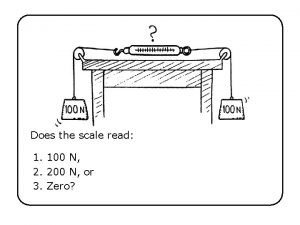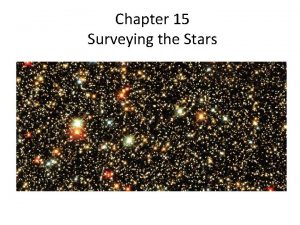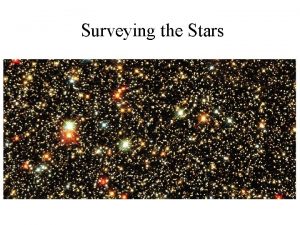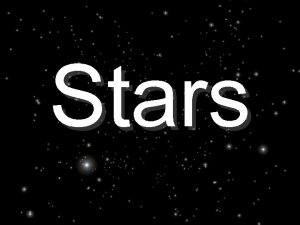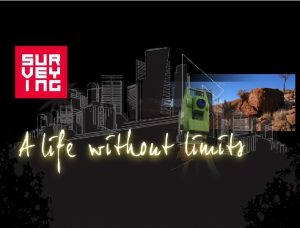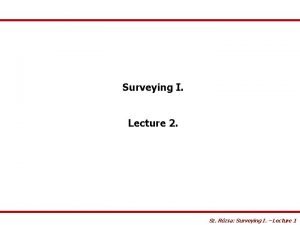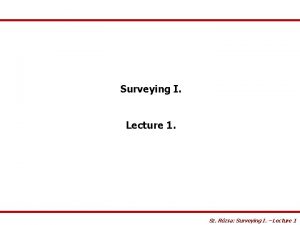Chapter 15 Surveying the Stars Most massive stars






















- Slides: 22

Chapter 15 Surveying the Stars

Most massive stars are 100 MSun Least massive stars are 0. 08 MSun (MSun is the mass of the Sun)

Luminosity: Amount of energy a star radiates each second Apparent brightness: Amount of starlight that reaches Earth (energy per second per square meter)

Inverse Square Law Sun is very bright, but is the Sun really a “bright” star? The amount of light received from a star decreases with distance from the star. Example: 10 ly = 100 photons 20 ly = ? photons 2 x farther = 22 or 4 times dimmer, so only 100/4 = 25 photons

Most luminous stars: 106 Lsun Least luminous stars: 10 -4 LSun (LSun is luminosity of Sun)

Apparent magnitude • measures apparent brightness • 2 nd century BC Hipparchus • 6 categories of brightness ( 1 st mag. = the brightest, 6 th mag. = the faintest) • backward scale: brighter = lower the magnitude.

How it works: • There is a 100: 1 ratio of brightness over magnitudes 1 → 6 • So each magnitude difference is 5√ 100 = 2. 5 brightness

• Apparent magnitude depends on – distance – luminosity

Absolute Magnitude Measures the true brightness of a star To find the absolute magnitude, M, of a star we need to know: -Apparent magnitude, m -Distance from us, d Absolute magnitude is given by: m – M = 5 log (d – 5)

Parallax and distance Parallax: the apparent shift in position of a nearby object against a background of more distant objects


• Apparent positions of nearest stars shift by about an arcsecond as Earth orbits Sun

How do we measure stellar temperatures? Every object emits thermal radiation with a spectrum that depends on its temperature An object of fixed size grows more luminous as its temperature rises

Properties of Thermal Radiation 1. Hotter objects emit more light per unit area at all frequencies. 2. Hotter objects emit photons with a higher average energy.

Wien’s Law: 1/T higher temperature shorter wavelengths “bluer” star.

Hottest stars are 50, 000 K Coolest stars are 3, 000 K (Sun’s surface is 5, 800 K)

Absorption lines in star’s spectrum tell us ionization level

106 K 105 K 104 K Ionized Gas (Plasma) 103 K Neutral Gas 102 K Molecules 10 K Solid Level of ionization also reveals a star’s temperature


Absorption lines in a star’s spectrum correspond to a spectral type that reveals its temperature. O B A F G K M (Hottest) (Coolest) Also each spectral class is divided into 10: Sun G 2

Why no green stars?

• Remember, the spectra of stars differ because of differences in surface temperature. • All stars are made of the same “stuff” – 75% Hydrogen – 21 -24% Helium – 4% or less of heavy elements like Neon, Oxygen, Sulfur, Iron and Chlorine.
 Life cycle of a small to medium star
Life cycle of a small to medium star The rwenzori mountains mary daniels is a student in england
The rwenzori mountains mary daniels is a student in england There once was a woman from china who had a massive
There once was a woman from china who had a massive Topography associated with massive igneous rock
Topography associated with massive igneous rock Seabed massive sulphides (sms)
Seabed massive sulphides (sms) Massive transformative purpose examples
Massive transformative purpose examples Complications of blood transfusion
Complications of blood transfusion Arnold strongman and suzie small
Arnold strongman and suzie small Cs 246 stanford
Cs 246 stanford Excessive use of ornamentation and massive proportions
Excessive use of ornamentation and massive proportions Massive transfusion complication
Massive transfusion complication Blood loss
Blood loss A scalable bootstrap for massive data
A scalable bootstrap for massive data Mining massive datasets
Mining massive datasets Massive hemothorax
Massive hemothorax Tension pneumothorax triad
Tension pneumothorax triad Massive wood chipper
Massive wood chipper Hémiplégie massive proportionnelle
Hémiplégie massive proportionnelle A small sports car collides head on with a massive truck
A small sports car collides head on with a massive truck Mining of massive datasets solution
Mining of massive datasets solution Mtp template
Mtp template Stanford mining massive datasets
Stanford mining massive datasets Massive.io
Massive.io







